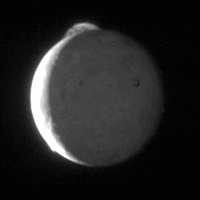Tvashtar Paterae


Tvashtar Paterae compose an active volcanic region of Jupiter's moon Io located near the moon's north pole. It is a series of paterae, or volcanic craters. It is named after Tvashtar, the Hindu god of blacksmiths.[1] Tvashtar was studied by the Galileo spacecraft over several years. During this time, a 25 km long, 1 to 2 km high curtain of lava was seen to erupt from one patera, a lake of superheated silicate lava erupted in the largest patera, and finally a plume of gas burst out, rising 385 km above the moon and blanketing areas as far away as 700 km.[2]
An eruption on Tvashtar on February 26 2007 was photographed by the New Horizons probe as it went past Jupiter en route to Pluto. The probe observed an enormous 290 km (180 miles) high plume from the volcano, with an as-yet unexplained filamentary structure made clearly visible by the background light from the sun.[3]
See also
References
- ^ "US Geological Planetary Nomenclature".
{{cite web}}: Unknown parameter|accessmonthday=ignored (help); Unknown parameter|accessyear=ignored (|access-date=suggested) (help) - ^ "University of Arizona Planetary Image Research Laboratory May 28, 2002 Report on Tvashtar Paterae".
{{cite web}}: Unknown parameter|accessmonthday=ignored (help); Unknown parameter|accessyear=ignored (|access-date=suggested) (help) - ^ Mission Photos: An Eruption on Io (New Horizons) Retrieved on February 28 2007.
